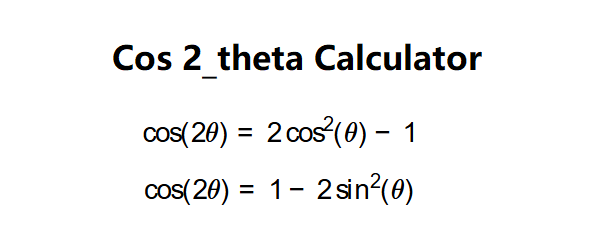1. What is a Cos 2 Theta Calculator?
Definition: This calculator computes the cosine of a double angle, \( \cos(2\theta) \), using the double angle identity for cosine. The user inputs either \( \cos(\theta) \) or \( \sin(\theta) \), and the calculator returns \( \cos(2\theta) \). It also displays the equivalent angle \( 2\theta \) in degrees or radians, defaulting to degrees.
Purpose: It aids in trigonometry education and practical applications by simplifying the calculation of double angle cosine values, useful in fields like physics, engineering, and geometry for solving problems involving periodic functions or triangles.
2. How Does the Calculator Work?
The calculator uses the double angle identity for cosine, which can be expressed in two forms depending on the input:
- If \( \cos(\theta) \) is given: \( \cos(2\theta) = 2\cos^2(\theta) - 1 \)
- If \( \sin(\theta) \) is given: \( \cos(2\theta) = 1 - 2\sin^2(\theta) \)
To display the equivalent angle \( 2\theta \):
- Compute \( \theta = \arccos(\cos(\theta)) \) or \( \theta = \arcsin(\sin(\theta)) \) in radians.
- Calculate \( 2\theta = 2 \times \theta \).
- Convert \( 2\theta \) to degrees if selected: \( \text{degrees} = \text{radians} \times \frac{180}{\pi} \).
Steps:
- Select the input parameter (\( \cos(\theta) \) or \( \sin(\theta) \)).
- Input the value, which must be between -1 and 1.
- Validate the input to ensure it lies within the domain.
- Compute \( \cos(2\theta) \) using the appropriate double angle formula.
- Calculate the equivalent angle \( 2\theta \) and convert it to the user-selected unit (degrees or radians).
- Display the results to 4 decimal places.
3. Importance of Cos 2 Theta Calculations
Double angle cosine calculations are essential for:
- Trigonometry: Simplifying expressions involving double angles, often encountered in solving trigonometric equations.
- Physics: Analyzing wave phenomena or oscillatory motion, where double angles appear in formulas for frequency or phase shifts.
- Engineering: Designing systems involving periodic signals, such as in signal processing, where angle units may need conversion between degrees and radians.
4. Using the Calculator
Examples:
- Given \( \cos(\theta) \): \( \cos(\theta) = 1 \), Angle in degrees
\( \cos(2\theta) = 2(1)^2 - 1 = 1.0000 \),
\( \theta = \arccos(1) = 0 \), \( 2\theta = 0.0000^\circ \), or 0.0000 radians.
- Given \( \cos(\theta) \): \( \cos(\theta) = 0 \), Angle in degrees
\( \cos(2\theta) = 2(0)^2 - 1 = -1.0000 \),
\( \theta = \arccos(0) = \frac{\pi}{2} \), \( 2\theta = 180.0000^\circ \), or 3.1416 radians.
- Given \( \sin(\theta) \): \( \sin(\theta) = 0.342 \), Angle in degrees
\( \cos(2\theta) = 1 - 2(0.342)^2 = 0.7660 \),
\( \theta = \arcsin(0.342) \approx 20^\circ \), \( 2\theta = 40.0000^\circ \), or 0.6981 radians.
- Given \( \sin(\theta) \): \( \sin(\theta) = \frac{\sqrt{3}}{2} \approx 0.8660 \), Angle in radians
\( \cos(2\theta) = 1 - 2(0.8660)^2 \approx -0.5000 \),
\( \theta = \arcsin(0.8660) \approx \frac{\pi}{3} \), \( 2\theta = \frac{2\pi}{3} \approx 2.0944 \) radians, or 120.0000 degrees.
5. Frequently Asked Questions (FAQ)
Q: Why must the input value be between -1 and 1?
A: The input represents \( \cos(\theta) \) or \( \sin(\theta) \), which are trigonometric functions that only take values between -1 and 1. Values outside this range do not correspond to any real angle.
Q: Why does the angle output default to degrees?
A: Degrees are a common unit in many applications and are more intuitive for most users. However, you can switch to radians using the dropdown.
Q: What is the double angle identity for cosine?
A: The double angle identity for cosine can be expressed as \( \cos(2\theta) = 2\cos^2(\theta) - 1 \) when \( \cos(\theta) \) is known, or \( \cos(2\theta) = 1 - 2\sin^2(\theta) \) when \( \sin(\theta) \) is known. These identities allow you to compute the cosine of a double angle using a single trigonometric value.
 Home
Home
 Back
Back
